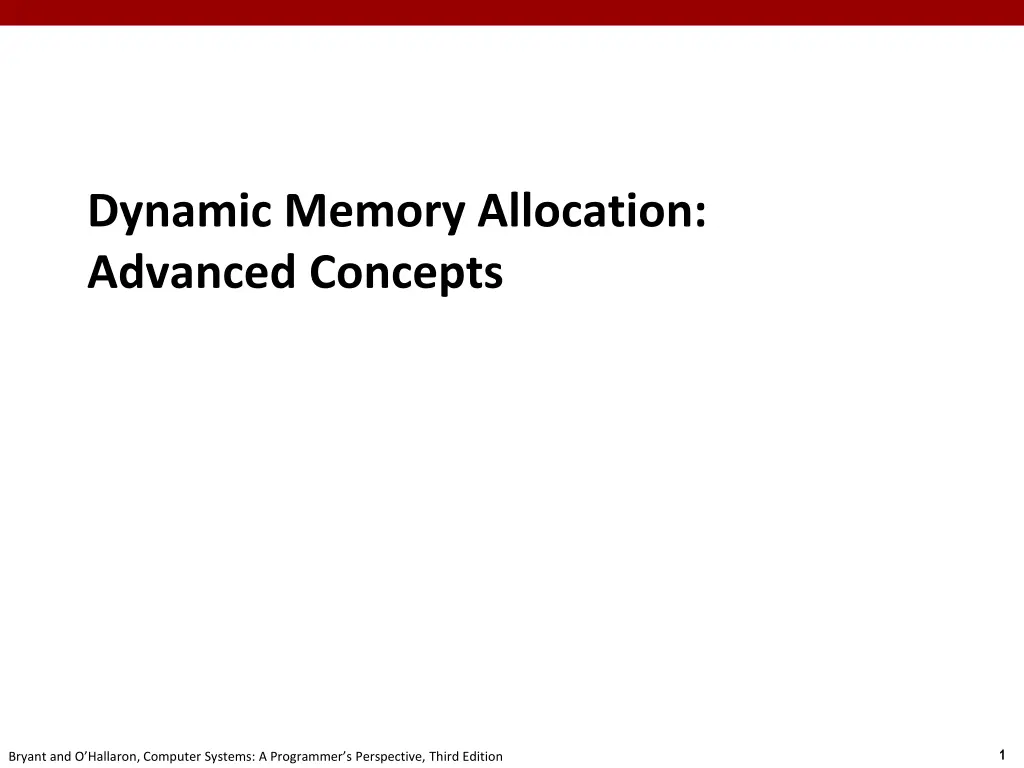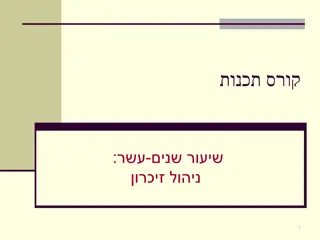
Dynamic Memory Allocation Advanced Concepts in Computer Systems
Explore advanced concepts in dynamic memory allocation, including explicit and segregated free lists, garbage collection, memory-related perils, and pitfalls. Learn methods for keeping track of free blocks and allocating from explicit free lists. Understand insertion policies for freeing with explicit free lists to optimize memory management.
Download Presentation

Please find below an Image/Link to download the presentation.
The content on the website is provided AS IS for your information and personal use only. It may not be sold, licensed, or shared on other websites without obtaining consent from the author. If you encounter any issues during the download, it is possible that the publisher has removed the file from their server.
You are allowed to download the files provided on this website for personal or commercial use, subject to the condition that they are used lawfully. All files are the property of their respective owners.
The content on the website is provided AS IS for your information and personal use only. It may not be sold, licensed, or shared on other websites without obtaining consent from the author.
E N D
Presentation Transcript
Dynamic Memory Allocation: Advanced Concepts 1 Bryant and O Hallaron, Computer Systems: A Programmer s Perspective, Third Edition
Today Explicit free lists Segregated free lists Garbage collection Memory-related perils and pitfalls 2 Bryant and O Hallaron, Computer Systems: A Programmer s Perspective, Third Edition
Keeping Track of Free Blocks Method 1: Implicit free list using length links all blocks 5 4 6 2 Method 2: Explicit free list among the free blocks using pointers 5 4 6 2 Method 3: Segregated free list Different free lists for different size classes Method 4: Blocks sorted by size Can use a balanced tree (e.g. Red-Black tree) with pointers within each free block, and the length used as a key 3 Bryant and O Hallaron, Computer Systems: A Programmer s Perspective, Third Edition
Explicit Free Lists Free Allocated (as before) Size a Size a Next Prev Payload and padding Size a Size a Maintain list(s) of free blocks, not all blocks The next free block could be anywhere So we need to store forward/back pointers, not just sizes Still need boundary tags for coalescing Luckily we track only free blocks, so we can use payload area 4 Bryant and O Hallaron, Computer Systems: A Programmer s Perspective, Third Edition
Explicit Free Lists Logically: A B C Physically: blocks can be in any order Forward (next) links A B 4 4 4 4 6 6 4 4 4 4 C Back (prev) links 5 Bryant and O Hallaron, Computer Systems: A Programmer s Perspective, Third Edition
Allocating From Explicit Free Lists conceptual graphic Before After (with splitting) = malloc( ) 6 Bryant and O Hallaron, Computer Systems: A Programmer s Perspective, Third Edition
Freeing With Explicit Free Lists Insertion policy: Where in the free list do you put a newly freed block? LIFO (last-in-first-out) policy Insert freed block at the beginning of the free list Pro: simple and constant time Con: studies suggest fragmentation is worse than address ordered Address-ordered policy Insert freed blocks so that free list blocks are always in address order: addr(prev) < addr(curr) < addr(next) Con: requires search Pro: studies suggest fragmentation is lower than LIFO 7 Bryant and O Hallaron, Computer Systems: A Programmer s Perspective, Third Edition
Freeing With a LIFO Policy (Case 1) conceptual graphic Before free( ) Root Insert the freed block at the root of the list After Root 8 Bryant and O Hallaron, Computer Systems: A Programmer s Perspective, Third Edition
Freeing With a LIFO Policy (Case 2) conceptual graphic Before free( ) Root Splice out successor block, coalesce both memory blocks and insert the new block at the root of the list After Root 9 Bryant and O Hallaron, Computer Systems: A Programmer s Perspective, Third Edition
Freeing With a LIFO Policy (Case 3) conceptual graphic Before free( ) Root Splice out predecessor block, coalesce both memory blocks, and insert the new block at the root of the list After Root 10 Bryant and O Hallaron, Computer Systems: A Programmer s Perspective, Third Edition
Freeing With a LIFO Policy (Case 4) conceptual graphic Before free( ) Root Splice out predecessor and successor blocks, coalesce all 3 memory blocks and insert the new block at the root of the list After Root 11 Bryant and O Hallaron, Computer Systems: A Programmer s Perspective, Third Edition
Explicit List Summary Comparison to implicit list: Allocate is linear time in number of free blocks instead of all blocks Much faster when most of the memory is full Slightly more complicated allocate and free since needs to splice blocks in and out of the list Some extra space for the links (2 extra words needed for each block) Does this increase internal fragmentation? Most common use of linked lists is in conjunction with segregated free lists Keep multiple linked lists of different size classes, or possibly for different types of objects 12 Bryant and O Hallaron, Computer Systems: A Programmer s Perspective, Third Edition
Keeping Track of Free Blocks Method 1: Implicit list using length links all blocks 5 4 6 2 Method 2: Explicit list among the free blocks using pointers 5 4 6 2 Method 3: Segregated free list Different free lists for different size classes Method 4: Blocks sorted by size Can use a balanced tree (e.g. Red-Black tree) with pointers within each free block, and the length used as a key 13 Bryant and O Hallaron, Computer Systems: A Programmer s Perspective, Third Edition
Today Explicit free lists Segregated free lists Garbage collection Memory-related perils and pitfalls 14 Bryant and O Hallaron, Computer Systems: A Programmer s Perspective, Third Edition
Segregated List (Seglist) Allocators Each size class of blocks has its own free list 1-2 3 4 5-8 9-inf Often have separate classes for each small size For larger sizes: One class for each two-power size 15 Bryant and O Hallaron, Computer Systems: A Programmer s Perspective, Third Edition
Seglist Allocator Given an array of free lists, each one for some size class To allocate a block of size n: Search appropriate free list for block of size m > n If an appropriate block is found: Split block and place fragment on appropriate list (optional) If no block is found, try next larger class Repeat until block is found If no block is found: Request additional heap memory from OS (using sbrk()) Allocate block of n bytes from this new memory Place remainder as a single free block in largest size class. 16 Bryant and O Hallaron, Computer Systems: A Programmer s Perspective, Third Edition
Seglist Allocator (cont.) To free a block: Coalesce and place on appropriate list Advantages of seglist allocators Higher throughput log time for power-of-two size classes Better memory utilization First-fit search of segregated free list approximates a best-fit search of entire heap. Extreme case: Giving each block its own size class is equivalent to best-fit. 17 Bryant and O Hallaron, Computer Systems: A Programmer s Perspective, Third Edition
More Info on Allocators D. Knuth, The Art of Computer Programming , 2nd edition, Addison Wesley, 1973 The classic reference on dynamic storage allocation Wilson et al, Dynamic Storage Allocation: A Survey and Critical Review , Proc. 1995 Int l Workshop on Memory Management, Kinross, Scotland, Sept, 1995. Comprehensive survey Available from CS:APP student site (csapp.cs.cmu.edu) 18 Bryant and O Hallaron, Computer Systems: A Programmer s Perspective, Third Edition
Today Explicit free lists Segregated free lists Garbage collection Memory-related perils and pitfalls 19 Bryant and O Hallaron, Computer Systems: A Programmer s Perspective, Third Edition
Implicit Memory Management: Garbage Collection Garbage collection: automatic reclamation of heap-allocated storage application never has to free void foo() { int *p = malloc(128); return; /* p block is now garbage */ } Common in many dynamic languages: Python, Ruby, Java, Perl, ML, Lisp, Mathematica Variants ( conservative garbage collectors) exist for C and C++ However, cannot necessarily collect all garbage 20 Bryant and O Hallaron, Computer Systems: A Programmer s Perspective, Third Edition
Garbage Collection How does the memory manager know when memory can be freed? In general we cannot know what is going to be used in the future since it depends on conditionals But we can tell that certain blocks cannot be used if there are no pointers to them Must make certain assumptions about pointers Memory manager can distinguish pointers from non-pointers All pointers point to the start of a block Cannot hide pointers (e.g., by coercing them to an int, and then back again) 21 Bryant and O Hallaron, Computer Systems: A Programmer s Perspective, Third Edition
Classical GC Algorithms Mark-and-sweep collection (McCarthy, 1960) Does not move blocks (unless you also compact ) Reference counting (Collins, 1960) Does not move blocks (not discussed) Copying collection (Minsky, 1963) Moves blocks (not discussed) Generational Collectors (Lieberman and Hewitt, 1983) Collection based on lifetimes Most allocations become garbage very soon So focus reclamation work on zones of memory recently allocated For more information: Jones and Lin, Garbage Collection: Algorithms for Automatic Dynamic Memory , John Wiley & Sons, 1996. 22 Bryant and O Hallaron, Computer Systems: A Programmer s Perspective, Third Edition
Memory as a Graph We view memory as a directed graph Each block is a node in the graph Each pointer is an edge in the graph Locations not in the heap that contain pointers into the heap are called root nodes (e.g. registers, locations on the stack, global variables) Root nodes Heap nodes reachable Not-reachable (garbage) A node (block) is reachable if there is a path from any root to that node. Non-reachable nodes are garbage (cannot be needed by the application) 23 Bryant and O Hallaron, Computer Systems: A Programmer s Perspective, Third Edition
Mark and Sweep Collecting Can build on top of malloc/free package Allocate using mallocuntil you run out of space When out of space: Use extra mark bitin the head of each block Mark: Start at roots and set mark bit on each reachable block Sweep: Scan all blocks and free blocks that are not marked root Note: arrows here denote memory refs, not free list ptrs. Before mark After mark Mark bit set After sweep free free 24 Bryant and O Hallaron, Computer Systems: A Programmer s Perspective, Third Edition
Assumptions For a Simple Implementation Application new(n): returns pointer to new block with all locations cleared read(b,i):read location i of block b into register write(b,i,v): write v into location i of block b Each block will have a header word addressed as b[-1], for a block b Used for different purposes in different collectors Instructions used by the Garbage Collector is_ptr(p): determines whether p is a pointer length(b): returns the length of block b, not including the header get_roots(): returns all the roots 25 Bryant and O Hallaron, Computer Systems: A Programmer s Perspective, Third Edition
Mark and Sweep (cont.) Mark using depth-first traversal of the memory graph ptr mark(ptr p) { if (!is_ptr(p)) return; // do nothing if not pointer if (markBitSet(p)) return; // check if already marked setMarkBit(p); // set the mark bit for (i=0; i < length(p); i++) // call mark on all words mark(p[i]); // in the block return; } Sweep using lengths to find next block ptr sweep(ptr p, ptr end) { while (p < end) { if markBitSet(p) clearMarkBit(); else if (allocateBitSet(p)) free(p); p += length(p); } 26 Bryant and O Hallaron, Computer Systems: A Programmer s Perspective, Third Edition
Conservative Mark & Sweep in C A conservative garbage collector for C programs is_ptr()determines if a word is a pointer by checking if it points to an allocated block of memory But, in C pointers can point to the middle of a block ptr Header So how to find the beginning of the block? Can use a balanced binary tree to keep track of all allocated blocks (key is start-of-block) Balanced-tree pointers can be stored in header (use two additional words) Head Data Size Left: smaller addresses Right: larger addresses Left Right 27 Bryant and O Hallaron, Computer Systems: A Programmer s Perspective, Third Edition
Today Explicit free lists Segregated free lists Garbage collection Memory-related perils and pitfalls 28 Bryant and O Hallaron, Computer Systems: A Programmer s Perspective, Third Edition
Memory-Related Perils and Pitfalls Dereferencing bad pointers Reading uninitialized memory Overwriting memory Referencing nonexistent variables Freeing blocks multiple times Referencing freed blocks Failing to free blocks 29 Bryant and O Hallaron, Computer Systems: A Programmer s Perspective, Third Edition
C operators Operators () [] -> . ! ~ ++ -- + - * & (type) sizeof right to left * / % + - << >> < <= > >= == != & ^ | && || ?: = += -= *= /= %= &= ^= != <<= >>= , Associativity left to right left to right left to right left to right left to right left to right left to right left to right left to right left to right left to right right to left right to left left to right ->, (), and [] have high precedence, with * and & just below Unary +, -, and * have higher precedence than binary forms Source: K&R page 53 30 Bryant and O Hallaron, Computer Systems: A Programmer s Perspective, Third Edition
C Pointer Declarations: Test Yourself! int *p p is a pointer to int int *p[13] p is an array[13] of pointer to int int *(p[13]) p is an array[13] of pointer to int p is a pointer to a pointer to an int int **p int (*p)[13] p is a pointer to an array[13] of int f is a function returning a pointer to int int *f() int (*f)() f is a pointer to a function returning int f is a function returning ptr to an array[13] of pointers to functions returning int int (*(*f())[13])() x is an array[3] of pointers to functions returning pointers to array[5] of ints int (*(*x[3])())[5] Source: K&R Sec 5.12 31 Bryant and O Hallaron, Computer Systems: A Programmer s Perspective, Third Edition
Dereferencing Bad Pointers The classic scanf bug int val; ... scanf( %d , val); 32 Bryant and O Hallaron, Computer Systems: A Programmer s Perspective, Third Edition
Reading Uninitialized Memory Assuming that heap data is initialized to zero /* return y = Ax */ int *matvec(int **A, int *x) { int *y = malloc(N*sizeof(int)); int i, j; for (i=0; i<N; i++) for (j=0; j<N; j++) y[i] += A[i][j]*x[j]; return y; } 33 Bryant and O Hallaron, Computer Systems: A Programmer s Perspective, Third Edition
Overwriting Memory Allocating the (possibly) wrong sized object int **p; p = malloc(N*sizeof(int)); for (i=0; i<N; i++) { p[i] = malloc(M*sizeof(int)); } 34 Bryant and O Hallaron, Computer Systems: A Programmer s Perspective, Third Edition
Overwriting Memory Off-by-one error int **p; p = malloc(N*sizeof(int *)); for (i=0; i<=N; i++) { p[i] = malloc(M*sizeof(int)); } 35 Bryant and O Hallaron, Computer Systems: A Programmer s Perspective, Third Edition
Overwriting Memory Not checking the max string size char s[8]; int i; gets(s); /* reads 123456789 from stdin */ Basis for classic buffer overflow attacks 36 Bryant and O Hallaron, Computer Systems: A Programmer s Perspective, Third Edition
Overwriting Memory Misunderstanding pointer arithmetic int *search(int *p, int val) { while (*p && *p != val) p += sizeof(int); return p; } 37 Bryant and O Hallaron, Computer Systems: A Programmer s Perspective, Third Edition
Overwriting Memory Referencing a pointer instead of the object it points to int *BinheapDelete(int **binheap, int *size) { int *packet; packet = binheap[0]; binheap[0] = binheap[*size - 1]; *size--; Heapify(binheap, *size, 0); return(packet); } 38 Bryant and O Hallaron, Computer Systems: A Programmer s Perspective, Third Edition
Referencing Nonexistent Variables Forgetting that local variables disappear when a function returns int *foo () { int val; return &val; } 39 Bryant and O Hallaron, Computer Systems: A Programmer s Perspective, Third Edition
Freeing Blocks Multiple Times Nasty! x = malloc(N*sizeof(int)); <manipulate x> free(x); y = malloc(M*sizeof(int)); <manipulate y> free(x); 40 Bryant and O Hallaron, Computer Systems: A Programmer s Perspective, Third Edition
Referencing Freed Blocks Evil! x = malloc(N*sizeof(int)); <manipulate x> free(x); ... y = malloc(M*sizeof(int)); for (i=0; i<M; i++) y[i] = x[i]++; 41 Bryant and O Hallaron, Computer Systems: A Programmer s Perspective, Third Edition
Failing to Free Blocks (Memory Leaks) Slow, long-term killer! foo() { int *x = malloc(N*sizeof(int)); ... return; } 42 Bryant and O Hallaron, Computer Systems: A Programmer s Perspective, Third Edition
Failing to Free Blocks (Memory Leaks) Freeing only part of a data structure struct list { int val; struct list *next; }; foo() { struct list *head = malloc(sizeof(struct list)); head->val = 0; head->next = NULL; <create and manipulate the rest of the list> ... free(head); return; } 43 Bryant and O Hallaron, Computer Systems: A Programmer s Perspective, Third Edition
Dealing With Memory Bugs Debugger: gdb Good for finding bad pointer dereferences Hard to detect the other memory bugs Data structure consistency checker Runs silently, prints message only on error Use as a probe to zero in on error Binary translator: valgrind Powerful debugging and analysis technique Rewrites text section of executable object file Checks each individual reference at runtime Bad pointers, overwrites, refs outside of allocated block glibc malloc contains checking code setenv MALLOC_CHECK_ 3 export MALLOC_CHECK_=3 44 Bryant and O Hallaron, Computer Systems: A Programmer s Perspective, Third Edition






















